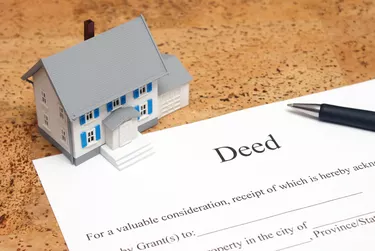
Tip
To ensure that you get the best rates on your loan, include different lender types in your search such as banks, finance companies, credit unions, savings and loans, mortgage lenders and online lenders.
Warning
If a lender makes you uncomfortable with aggressive lending tactics or suggests that you falsify information on your loan paperwork, cancel your application before you finalize your loan and seek out a different lender.
Providing collateral to secure a personal loan generally results in approvals for larger loan amounts and lower interest rates. The deed to your home can be used as collateral to secure a loan, though care must be taken to avoid falling behind on your loan payments and potentially losing your house. Before using the deed to your home to secure a personal loan you should make sure that you've found a lender that you can trust and have gotten a good deal on the loan you want.
Step 1
Determine exactly how much you need to borrow with your personal loan. This will help you to avoid unscrupulous lenders who try and talk you into borrowing larger amounts so that they can earn more interest.
Video of the Day
Step 2
Visit multiple lenders, requesting quotes for the best personal loans you will qualify for using the deed to your home as collateral. Provide the most accurate information that you can about your income, the value of your home or the amount of equity that you have and other information that may be required by the lender.
Step 3
Ask for specific information on the quotes such as the estimated monthly payment, the annual percentage rate and whether the APR is fixed or adjustable. Ask whether there are any points or other fees, if there is a prepayment penalty if you pay the loan off early and if the interest rate will increase due to late or missed payments. Make sure that the quotes include the type of loan being offered so that you'll know whether to expect balloon payments or other changes as the loan matures.
Step 4
Compare the quotes you receive. Consider not only the monthly payment and interest rate but also the type of loan, how much each loan will cost out of pocket and whether you'll be able to repay the loans early without suffering a penalty. Narrow down the quotes based on which loan offers are the best overall to determine which loan you want.
Step 5
Return to the lender that offered you the best quote, asking to speak with the same loan officer if possible. Reference the quote you received previously and inform him that you would like to apply for the loan.
Step 6
Ask for a blank copy of the final paperwork you will have to sign at closing before you leave. This allows you to review the loan agreement before it is finalized, checking it against the quoted loan terms to make sure that there aren't any conditions about which you weren't aware. Not all lenders will give you a blank copy of the loan forms, but most reputable lenders will.
Step 7
Return to the lender when contacted after your credit has been checked and your loan is approved. Take note of any changes in the APR caused by your credit, asking if it can be lowered if you feel that it is too high. Any changes that you want made to the loan must take place before you sign the closing papers; once the papers are signed you are locked in to the agreement. Once you are satisfied with the loan terms, sign the closing papers to finalize the loan.
Video of the Day